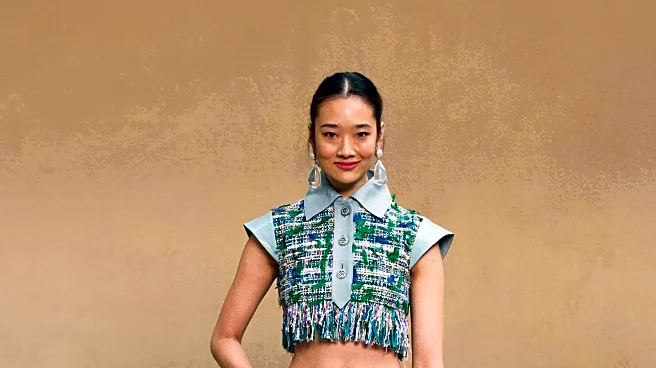What's Happening?
Arthur Arbesser has launched his Fall 2025 Ready-to-Wear collection, focusing on simplicity and sustainability. The designer transformed an old car-repair garage into a creative hub, emphasizing non-precious materials and direct-to-consumer sales. Arbesser's collection features revived fabrics and prints, including tobacco-and-black striped fabric from Backhausen and thousands of buttons as a recurring print. The collection also includes a collaboration with Hanro, introducing colorful lingerie to the Swiss brand's traditionally white nightwear. Arbesser aims to create clothing for real people, making space for different generations through sophisticated plays of color and volume.
Why It's Important?
Arthur Arbesser's approach challenges the fashion industry's push for larger scale operations, highlighting the importance of sustainability and personal connection in design. By adopting a direct-to-consumer model, Arbesser aligns with a growing trend among independent labels seeking to bypass traditional retail channels. This strategy allows for greater control over production and pricing, potentially benefiting consumers with more affordable and unique fashion options. The collaboration with Hanro introduces a fresh perspective to a longstanding brand, showcasing the potential for innovation within established companies.
What's Next?
Arthur Arbesser's move to a direct-to-consumer model may inspire other designers to reconsider their business strategies, particularly in the face of industry pressures for expansion. The success of this collection could lead to further collaborations with established brands, expanding Arbesser's influence in the fashion world. As the collection gains traction, it may prompt discussions on the sustainability of fashion practices and the importance of catering to diverse age groups in design.
Beyond the Headlines
Arbesser's focus on non-precious materials and the revival of forgotten objects raises questions about the ethical implications of fashion consumption. By prioritizing sustainability and inclusivity, Arbesser challenges the industry's norms, potentially influencing cultural attitudes towards fashion and consumerism. His approach may encourage a shift towards valuing craftsmanship and personal expression over mass production and fleeting trends.










